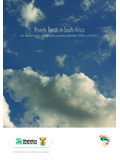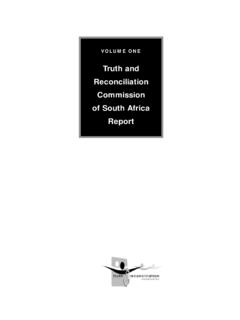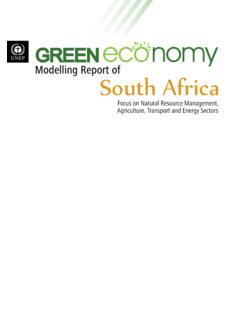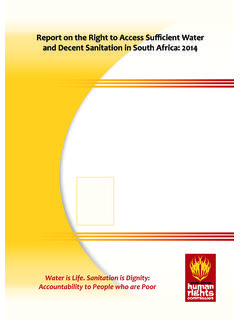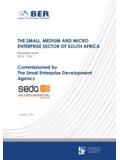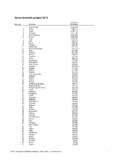Transcription of INCIDENCE OF HISTOLOGICALLY DIAGNOSED CANCER IN …
1 INCIDENCE OF HISTOLOGICALLYDIAGNOSED CANCER INSOUTH africa ,1998 1999 Nokuzola Mqoqi,1 MSc (University of Natal), (PHDC) (LSHTM, University of London)Patricia Kellett, Tech (Wits Technikon)Freddy Sitas,2D. Phil. (University of Oxford)Musa Jula,1N. Dip IT (Technikon SA)NATIONAL CANCER REGISTRYThe National CANCER Registry is a co-operative venture of the Department of Health, the CancerAssociation of south africa , the National Health Laboratory Service and the University of theWitwatersrandDepartment of Anatomical Pathology, School of Pathology, Wits University1 National Health Laboratory Service (Previously SAIMR)
2 P O Box 1038, Johannesburg, 2000, south AfricaThe CANCER Council, New south Wales 2P O Box 572, Kings Cross, New south Wales, 1340, AustraliaPublished by the National CANCER Registry of south africa , National Health Laboratory Service, 2004cancer98_contents4/4/05, 14:371 CONTENTSLIST OF FIGURESiLIST OF TABLESiiNATIONAL CANCER REGISTRYiiiFOREWORDivCHAIRPERSON S COMMENTvACKNOWLEDGEMENTSviFUNDINGviiEXEC UTIVE collection and data of quality and quality Completeness of Unique identification and use of of CANCER INCIDENCE reported in 1998 and of new cancers in 1998 and distribution of CANCER Distribution of CANCER sites by age of CANCER in 1998 and by CANCER of the CANCER of the Colorectal Colon Female breast Kaposi Lung
3 Non-Hodgkin Non-Melanoma skin Oesophagus Prostate CANCER of the , 14:382iLIST OF FIGURESF igure 1:Map of south Africa2 Figure 2: south africa s population, 19994 Figure 3:Percentage distribution of CANCER cases by race and year of diagnosis7 Figure 4:Percentage distribution of CANCER cases by diagnosing province and sex,1998 and 1999 combined12 Figure 5:Percentage distribution of cancers by years of diagnosis and population group12 Figure 6:Percentage distribution of new CANCER cases reported in 1998 and 1999 byage groups and sex (includes BCC and SCC of skin)13 Figure 7:Percentage distribution of 10 most common cancers by sex, 1998 and 1999 All ages14 Figure 8:Percentage distribution of 10 most common cancers by sex, 1998 and 1999 Ages 0-14 years14 Figure 9:Percentage distribution of 10 most common cancers by sex, 1998 and 1999 Ages 15-29 years15 Figure 10: Percentage distribution of 10 most common cancers by sex, 1998 and 1999 Ages 30-54 years15 Figure 11.
4 Percentage distribution of 10 most common cancers by sex, 1998 and 1999 Ages 55-64 years16 Figure 12: Percentage distribution of 10 most common cancers by sex, 1998 and 1999 Ages 65+16 Figure 13: Age specific INCIDENCE rates for bladder CANCER by population group, 199920 Figure 14: Bladder CANCER ASR per 100 000 for selected populations21 Figure 15: Age specific INCIDENCE rates for cervix CANCER by population group, 199923 Figure 16: Cervix CANCER ASR per 100 000 for selected populations23 Figure 17: Age specific INCIDENCE rates for colorectal CANCER by population group, 199925 Figure 18: Colorectal CANCER ASR per 100 000 for selected populations26 Figure 19: Age specific INCIDENCE rates for colon CANCER by population group, 199928 Figure 20: Colon CANCER ASR per 100 000 for selected populations29 Figure 21: Age specific INCIDENCE rates for female breast CANCER by population group, 199931 Figure 22: Female breast CANCER ASR per 100 000 for selected populations31 Figure 23.
5 Age specific INCIDENCE rates for Kaposi sarcoma by population group, 199933 Figure 24: Kaposi sarcoma ASR per 100 000 for selected populations34 Figure 25: Age specific INCIDENCE rates for lung CANCER by population group, 199936 Figure 26: Lung CANCER ASR per 100 000 for selected populations37 Figure 27: Age specific INCIDENCE rates for melanoma by population group, 199939 Figure 28: Melanoma ASR per 100 000 for selected populations40 Figure 29: Age specific INCIDENCE rates for non-Hodgkin lymphoma by population group, 199942 Figure 30: Non-Hodgkin lymphoma ASR per 100 000 for selected populations43 Figure 31: Age specific INCIDENCE rates for non-melanoma skin cancers by population group, 199945 Figure 32: Non-melanoma skin cancers ASR per 100 000 for selected populations46 Figure 33: Age specific INCIDENCE rates for oesophagus CANCER by population group, 199948 Figure 34: Oesophagus CANCER ASR per 100 000 for selected populations49 Figure 35.
6 Age specific INCIDENCE rates for prostate CANCER by population group, 199951 Figure 36: Prostate CANCER ASR per 100 000 for selected populations51 Figure 37: Age specific INCIDENCE rates for uterus CANCER by population group, 199953 Figure 38: Uterus CANCER ASR per 100 000 for selected populations53cancer98_prelim4/4/05, 14:381iiLIST OF TABLEST able 1:Direct Standardisation method for the CANCER of the cervix in black females, 19998 Table 2:Frequency distribution of CANCER diagnosing laboratories and cancers diagnosedin 1998 and 1999 by province11 Table 3:Frequency distribution of cancers by population group, sex and year of diagnosis13 Table 4:Summary rates for the leading five cancers by race group and sex, 1998 and 199917 Table 5:Summary statistics for bladder CANCER , 1998 and 199919 Table 6:Summary statistics for cervix CANCER , 1998 and 199922 Table 7:Summary statistics for colorectal CANCER , 1998 and 199924 Table 8.
7 Summary statistics for colon CANCER , 1998 and 199927 Table 9:Summary statistics for female breast CANCER , 1998 and 199930 Table 10:Summary statistics for Kaposi sarcoma, 1998 and 199932 Table 11:Summary statistics for lung CANCER , 1998 and 199935 Table 12:Summary statistics for melanoma, 1998 and 199938 Table 13:Summary statistics for non-Hodgkin lymphoma, 1998 and 199941 Table 14:Summary statistics for non-melanoma skin cancers, 1998 and 199944 Table 15:Summary statistics for oesophagus CANCER , 1998 and 199947 Table 16:Summary statistics for prostate CANCER , 1998 and 199950 Table 17:Summary statistics for CANCER of the uterus, 1998 and 199952cancer98_prelim4/4/05, 14:382ivFOREWORDThe 1998-1999 CANCER INCIDENCE report represents an important source of information for our understanding of cancerincidence patterns among the different race groups in south africa .
8 This report is a result of the dedication of theNational CANCER Registry staff and academicians in the fields of oncology, pathology, histology and Epidemiology. Thesupport from the private laboratory groups is acknowledged and represents a key aspect of public-private report is aimed at generating data on the important trends and patterns in HISTOLOGICALLY confirmed CANCER amongthe south African National CANCER Registry makes it possible for us to monitor and quantify the burden of CANCER disease in ourcountry by publishing CANCER INCIDENCE nationally.
9 We know that 25% of south African men and 20% of south Africanwomen will at some stage in their lifetime develop a CANCER ; and which cancers are most prevalent in which popula-tion groups, sex and age categories. Availability of this information has helped us to think more and focus our goalsconcerning CANCER disease. Our goal is to reduce morbidity and mortality from CANCER and improve the quality of lifeof CANCER patients. Important initiatives to prevent and control CANCER are being implemented by the Department ofHealth. These include the amendment of the Tobacco Products Control Act in 1999, a government effort to reducelung CANCER and other upper respiratory tract conditions, of which tobacco smoking is known to account for a largeproportion.
10 We are also implementing a cervical CANCER screening programme amidst some logistical challenges inorder to ensure effective implementation of this have also observed with alarm the increasing INCIDENCE of breast CANCER that is catching up with that of CANCER of thecervix in all population groups. These patterns are sending strong and bold messages for prevention and the Department of Health has to come up with cost-effective interventions, I am keen on future and more up-to-date trends on these cancers as an evaluation measure to evaluate our prevention sincere wish









